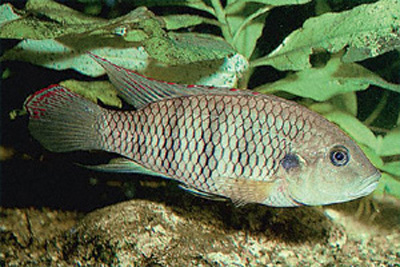| Cichlidae (Cichlids), subfamily: Pseudocrenilabrinae |
| 9.42 cm SL (male/unsexed) |
|
benthopelagic; freshwater; pH range: 6.5; dH range: 1 - 5, |
| Africa: south-western Cameroon (including the Sanaga, Lokoundje and Kienke systems), Equatorial Guinea (Mbini system) and northern Gabon; records from Fernando Poo (=Bioko) (Equatorial Guinea) need confirmation (Ref. 81260). |
|
Dorsal spines (total): 14-16; Dorsal soft rays (total): 9-11; Anal spines: 3-3; Anal soft rays: 7-8. Diagnosis: dorsal fin membrane pale, without dense black band; vertical bars on flanks usually strongly marked; if present on caudal fin, maculae are pale and restricted to the proximal region of the fin; female lacking belly coloration (Ref. 81260).
Description: body depth 31.9-41.6% SL, head length 33.3-39.2% SL; caudal peduncle deeper than long; some dorsal and anal fin rays elongated; upper part of caudal fin in males sometimes lobe-like and elongated (Ref. 81260).
Coloration: body brown, paler ventrally; 5-6 well marked, vertical bars usually present on flanks, stressed individuals often with 2 horizontal stripes overlapping the vertical bars (Ref. 52307, 81260). Dorsal and upper part of caudal with red margin (Ref. 81260). Chrome-colored/iridiscent region in soft dorsal fin more prominent in females than males, sometimes upper third of caudal also chrome-colored/iridescent (Ref. 52307, 81260). Males often with red maculae in soft dorsal and in proximal part of upper half of caudal (Ref. 81260). Body scales in males with black margins (Ref. 52307, 81260). Juveniles with "tilapia spot" that may be retained in adults (Ref. 81260). |
| Pair-bonding, larvophilic mouthbrooder (Ref. 52307, 81260)with delayed uptake (Ref. 81260). Spawns in caves (Ref. 52307, 81260). Both parents brood offspring (Ref. 81260). |
|
Vulnerable (VU); Date assessed: 16 February 2009 (B2ab(iii)) Ref. (130435)
|
| harmless |
Source and more info: www.fishbase.org. For personal, classroom, and other internal use only. Not for publication.

